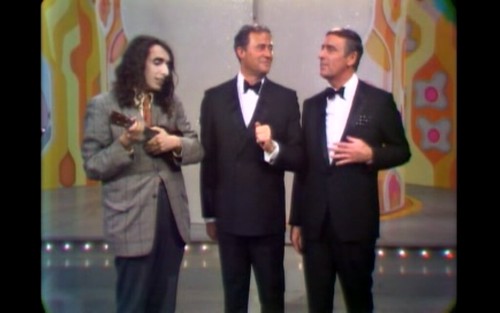Rowan and Martin's Laugh-In was an hour long sketch/variety show that NBC brought in to replace The Man From U.N.C.L.E. and it ran from January 1968 to May 1973. When the show started, it was at the height of popular viewing but it's ratings tanked until it was finally put out of it's misery. Quite simply, the show could not sustain it's style of humour past the Sixties, the decade in which everything changed.
Laugh-In was not as controversial as The Smothers Brothers, nor was it as surreal as the stuff that television's original genius, Ernie Kovacs did, although they did take the idea of black out skits from him and renamed them "Quickies".
However, Laugh-In did take the major social changes that were happening and present them to the general public and it did help them to gain a wider acceptance. Remember, just a couple of years before you would not have found jokes about premarital sex or extramarital affairs being accepted without consequences anywhere outside of certain night clubs in certain cities.
Now, what can I say about fashion on Laugh-In, which is the real reason why you would watch it. Well, it's full of both everyday style and outrageous Sixties fashions, particularly during the Cocktail Party scenes. Mini skirts, crazy earrings, giant hair, groovy tights and psychedelic prints abound. And just wait till you get a look at the over the top eye makeup. And for those of you with absolutely no interest in fashion, there are girls in bikinis. Or a man in a yellow raincoat riding a tricycle, whatever turns you on.
These are the stars of the show: Dan Rowan on the left and Dick Martin on the right. They had been doing a night club act for years with Dan playing the straight man and Dick playing the dumb guy. They kept this format when they moved to television.
There was also a huge cast of supporting comics getting their first break in television. The cast changed throughout the years, with each new cast member being slightly less funny then whomever they were replacing. However, this is where Goldie Hawn got her start playing the dumb blonde and halfway through the second season, Lily Tomlin joined the cast and this is where she created the character of Ernestine the telephone operator.
Here is Lily Tomlin as Ernestine talking to guest star Cher, back when she was still Cher Bono.
Laugh-In also introduced the world to a Tin Pan Alley scholar and ukulele player called Tiny Tim. The less said about that the better, but you can read about him here if you've never heard of him before.
Above you will find a sampler video containing some of the reoccuring bits that Laugh-In did, including the news, parodies of Sixties poetry and some of the reoccuring characters and catch phrases. They introduced a lot of catch phrases, including "You bet your bippy" as a way to get around the censors.
The most famous bit that Laugh-In did was called Quickies, which were very quick black out skits involving a set-up and a punch line or gag. They would sometimes separate these skits with clips of Go-Go dancers in bikinis with close-ups of slogans that were painted on their bodies, but I couldn't find a clip of them on YouTube. You've heard of how now television is geared towards promoting it's audience to have short attention spans? Well, Laugh-In started it.
By the way, you saw Richard Nixon say "Sock It to Me" in the second video? Well, that one appearance won him the presidential election. Or at least that's what he said.
The other famous thing that Laugh-In would do was a Cocktail Party, which is were most of their more daring social and political jokes were aired, since you aren't supposed to take anything seriously at a party.
Laugh-In also had numerous guest-stars every week. Basically, if you were famous in the Sixties, you were on Laugh-In at least once, but I think Sammy Davis holds the record. He's on almost every show, or at least the ones that are currently available for viewing.
Laugh-In would end every show with the seemingly unrehearsed Joke Wall. You can draw your own conclusions as to what's going on to the cast behind the scenes, but boy, they sure had fun.
Laugh-In is available on a few Best-Of DVDs and a few complete episodes are torrents. You can also watch the 1968 Holiday Special on YouTube.
You really don't have to watch more then a couple of episodes to get the idea. My Dad watched it live and he says that it was good but they just couldn't sustain it's style of humour for very long and he stopped watching once they started to air Monty Python in Canada.
The problem with Laugh-In is that it's style of humour is funny but forgettable. And it hasn't really aged well. You can't really watch more than a couple of episodes nor can you rewatch episodes over and over again like you can with Python because you don't notice new things. And the more times you hear the same quick joke the less funny it is. However, it is important to watch in order to understand the Sixties, particularly what was popular and what the average person was watching and found funny. If Mad Men ever returns to the air, this is era that they will be dealing with and they will be entirely remiss if they do not mention Laugh-In and it's impact.




No comments:
Post a Comment